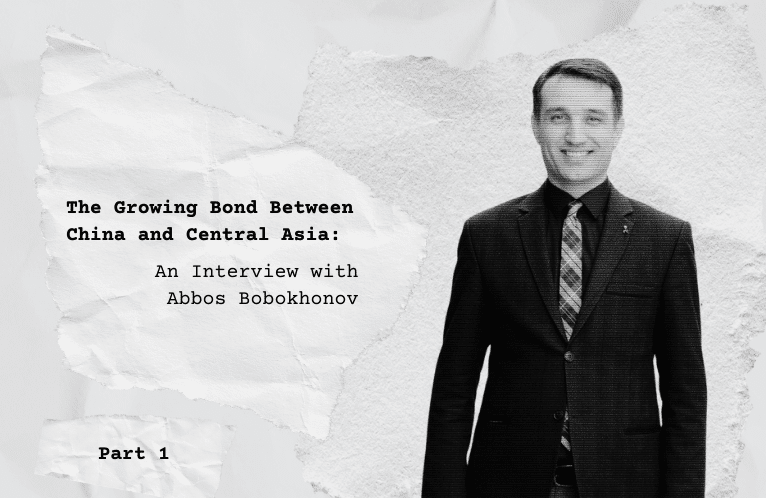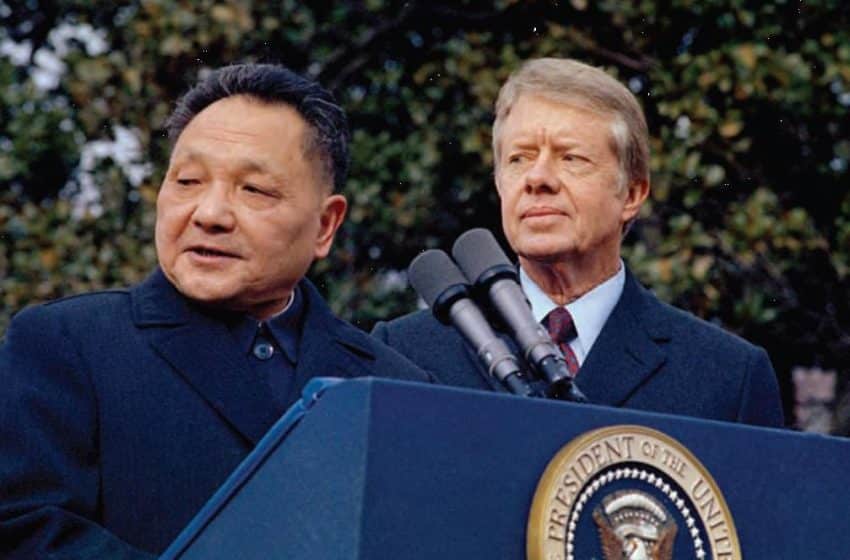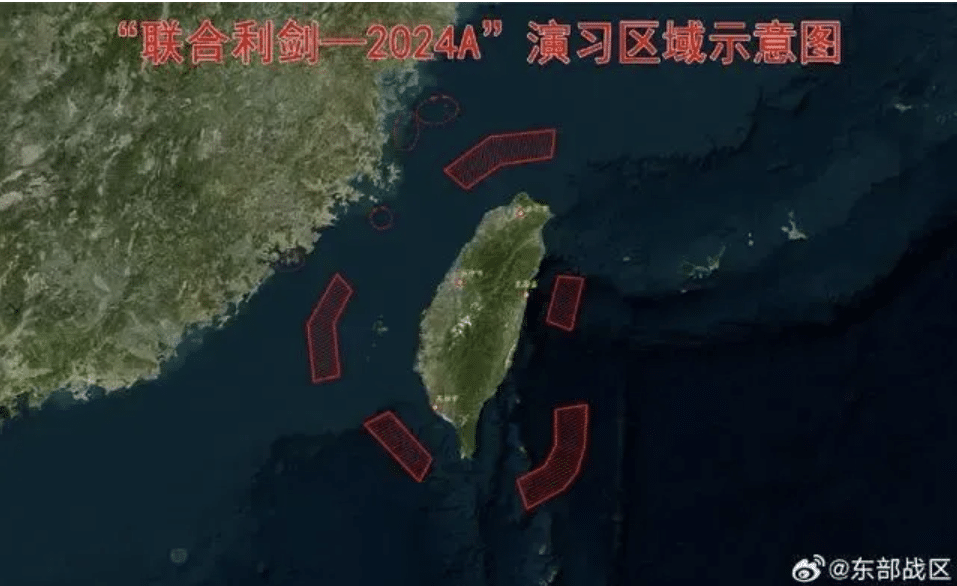The Growing Bond Between China and Central Asia: An Interview with Abbos Bobokhonov, Part 1
- Interviews
 Miranda Wilson
Miranda Wilson- 10/08/2024
- 0

While The Monitor’s main focus is usually the U.S.-China relationship, we recognize the growing importance of both China and the United States’ shifting alliances. One such alliance is the growing relationship between China and Central Asia.
We sit down with Dr. Abbos Bobokhonov to discuss China’s strategy towards the region. Recently, China has poured diplomatic resources into strengthening its presence and positive perception in Central Asia, from funding infrastructure projects to promoting its media outlets. China has taken a unique soft power approach to win Central Asia over; a necessary strategy since, as Dr. Bobokhonov notes, positive perceptions of China in the region are relatively low.
Another important factor in China-Central Asian relations is the looming shadow of Russian influence. However, Russia’s war with Ukraine has distracted it from other geopolitical relationships, and its neglect of Central Asia has left room for China to fill the gap. And because China is one of the few powers supporting Russia’s conquest of Ukraine, there is nothing Russia can say about China’s growing influence without risking losing its support.
In this two-part interview, we cover these complicated relationships as well as the Belt and Road Initiative, the Asian Infrastructure Investment Bank, and Dr. Bobokhonov’s recent visit to Xinjiang.
Abbos Bobokhonov holds a PhD in Political Science from the University of World Economy and Diplomacy. He received his Master’s degree in Theory and History of International Relations from the National University of Uzbekistan. He is a specialist with more than 15 years of experience in think tanks in Uzbekistan. Currently, Dr. Bobokhonov serves as the Head of the Indo-Pacific Studies Center (China Studies Program) at the Institute for Advanced International Studies at UWED. He has a great interest in China’s foreign and regional policy, including SCO, researching China’s policy in Central Asia, China’s “soft power” and media policy in Central Asia, and Uzbekistan-China bilateral relations. This fall, he is serving as a Fulbright visiting scholar at Georgia State University.
Miranda Wilson: In your opinion, what is China’s overall goal for its relationship with Central Asia?
Abbos Bobokhonov: In contemporary times, China has evolved into an indispensable partner for all five Central Asian republics. The level of dependency of the Central Asian states on China has been steadily increasing each year. Recent global events, ranging from the onset of COVID-19 to the Russian-Ukrainian crisis, have prompted China to critically reassess its role in the region. While the transformation of China’s role globally began with Xi Jinping’s coming to power and the introduction of the Belt and Road Initiative, it was post-COVID-19 that China swiftly evolved and initiated active engagement in regional affairs. Of particular note in this process is China’s diplomatic activity in Central Asia, whereby Beijing has managed to institutionalize China-Central Asian relations through an inaugural summit in Xi’an in 2023. The “China + Central Asia” format, followed by the establishment of a permanent Secretariat in Xian, in 2024.
Intensive visits by Chinese officials to Central Asian countries now encompass not only the traditional agenda of politics, economics, investment, and humanitarian cooperation but also focus on areas such as enhancing security and defense cooperation and jointly combating “color revolutions.” Just two decades ago, this scenario seemed incomprehensible, given Russia’s dominant presence with active military bases in Tajikistan and Kyrgyzstan and membership in the Collective Security Treaty Organization (CSTO), which served as a security guarantor for the Central Asian states.
The complex and unpredictable situation surrounding Russia, and notably the emerging trends in Central Asian and China relations, have further shifted dynamics in the region. Russia’s entanglement in the Ukrainian front has presented China with an opportunity to fully strategize its position in the region.
1) Beijing is keen on preserving its hard-earned position in the region. It is crucial for China to stay informed about regional developments and align positions with Central Asian leaders concerning bilateral relations. Mutual visits between Chinese leaders and those of Central Asian countries have become routine.
2) China is conducting targeted visits to countries in the region. For instance, earlier this year, four high-level authorities from China visited Central Asian countries to discuss various issues. The agenda in Kazakhstan primarily focused on agricultural cooperation, while in Uzbekistan, discussions centered on poverty alleviation strategies and the implementation of Chinese practices in the Uzbekistan context. Ensuring food security for the population has recently become a primary focus for the Chinese government. Meanwhile, agriculture stands as one of the key potential export sectors for Central Asian states to China.
For China, importing consumer goods from neighboring Central Asia is deemed safer and more advantageous than relying on risky maritime routes. Furthermore, Central Asia presents an alternative means of ensuring food security for Beijing in the event of delays or blockages in maritime trade routes for consumer goods.
3) The countries of Central Asia inherited a transport infrastructure closely linked with Russia from the USSR. Presently, China has nearly finalized plans for constructing an alternative railway infrastructure that will directly connect China with Kyrgyzstan, Uzbekistan, Tajikistan, and Turkmenistan. Upon the completion of the China-Kyrgyzstan-Uzbekistan railway (CKUR) project, China will gain an alternative and expedited transportation route to Central Asia and beyond.
In recent years, transporting goods through unstable maritime routes in the Pacific and Indian Oceans, including the Baltic Sea, has become risky for China. The construction of the CKUR will enable China to reduce its dependence on transit through the Northern Corridor while maintaining railway trade with Europe. Moreover, the CKUR will bolster economic development between Xinjiang and Central Asia. This initiative aligns with China’s broader foreign policy objectives, including the Belt and Road Initiative, aimed at strengthening ties and fostering economic cooperation across Eurasia.
4) Concurrently, the Minister of Defense of China visited Kazakhstan, and the Minister of Foreign Affairs visited Tajikistan to discuss matters pertaining to ensuring security and stability in the region with the respective officials of Kazakhstan and Tajikistan. During the visit to Tajikistan, Chinese Foreign Minister Wang Yi stated their readiness to enhance exchanges and consultations to combat external interference and collectively prevent the instigation of Color Revolutions. This sentiment echoes remarks previously made by Xi Jinping during bilateral meetings and at the inaugural “Central Asia-China” summit in Xi’an in 2023.
The reiteration of these concerns by the Chinese Foreign Minister during the visit to Tajikistan may be interpreted in two ways: Firstly, recent terror attacks in Russia’s Crocus City Hall and anti-government movements in Kazakhstan in January 2022, have prompted Chinese authorities to express serious concerns about the stability of the regional situation, which might impact the security of Chinese territories; Secondly, by highlighting the potential destabilization of the region and the prospect of a Color Revolution, the Chinese side may seek to actively participate in ensuring security and stability in the regional countries. Overall, these actions by China indicate an intention to gradually assume the role of the principal security partner for the region. Furthermore, due to China’s substantial investments in the region -around $40 billion, it will want to safeguard its economic interests in those countries.
Additionally, it is crucial to recognize that the situation in Xinjiang will always remain a cause for concern, thus making security a fundamentally critical focus and primary agenda of China’s foreign policy towards Central Asia.
China acknowledges the relative difficulty of establishing dominance of its culture in the region due to significant differences in traditions and values, as well as the prevailing influence of Russia. Therefore, through the deployment of “soft power,” China aims to maintain a “balance” of both negative and positive perceptions towards itself in Central Asian countries.
China aspires to retain its neutrality in international conflicts and avoid direct involvement in them to safeguard its interests. This stance could serve as a crucial factor in enhancing Central Asian countries’ trust in China. Emphasis on a multi-vector foreign policy approach by Central Asian countries may lead to China being regarded as a state uninvolved in conflicts and capable of upholding peace and stability in the region. This could bolster interest in the Chinese development model, particularly amidst escalating global geopolitical tensions.
On the whole, an analysis of China’s activities in Central Asia indicates Beijing’s intent to reshape the regional system without the involvement of Russia. This is a protracted process. The “institutionalization of interactions” within the Central Asia-China framework represents the initial systematic step towards this long-term objective.
MW: Broadly, how should we understand relations between Uzbekistan and China in the current geopolitical climate?
AB: The power transition in Uzbekistan in 2016 facilitated a fundamental shift, not only in the country’s political climate but also in how Uzbekistan is perceived by the global community.
Uzbekistan is pursuing a nuanced policy toward China. Maintenance of friendly relations between leaders sets the tone for intensifying exchanges between governmental and other parties in bilateral interactions. The significance of such a relationship is perhaps explained by the apparent similarity in political and economic development paths chosen by both states. In developing conceptual approaches to state development, both countries utilize five-year plans. Specifically, China has its “Five-Year Plans for State Development,” and Uzbekistan is implementing the “Development Strategy of New Uzbekistan for 2022-2026.” Such parallels encourage both sides to actively pursue mutual cooperation.
China’s policy in Uzbekistan, as in other states in the region, is not burdened by requirements or aspirations to influence domestic political processes. Consequently, this does not provide Uzbek authorities with a reason to distance themselves from China, as has been the case with Russia or the United States at different times, as you know. Nevertheless, over the past two decades, Uzbekistan has endeavored to balance China’s position and role in its economy and foreign relations by actively engaging other regional countries.
However, in the last two years, there has been a gradual shift, with an increase in mutual ties and visits between the leaders of the two countries. Previously, there were thoughts that despite the growing ties between Tashkent and Beijing, China’s influence in Uzbekistan remained the lowest compared to all other Central Asian countries. At this stage, new circumstances are emerging that could alter the current state of affairs.
First, China has practically solidified its status as Uzbekistan’s largest trade and investment partner. Between 2000 and 2022, the annual trade turnover between Uzbekistan and China increased by 78.5 times, from $95.5 million to $7.5 billion. By the end of 2023, the trade turnover reached $14 billion. But more importantly, Uzbekistan’s trade deficit is increasing. This is largely explained by Uzbekistan purchasing machinery, equipment, and technology from China. However, it is important to note that China is taking the lead in sectors where Uzbekistan has its own capabilities.
Regarding China’s investment activity in Uzbekistan, there is a steady growth trend. The total volume of Chinese investments between 2017 and 2022 amounted to nearly $11 billion. According to official statistics, over 2500 joint ventures are operating in Uzbekistan with Chinese capital. Last year in 2023, 601 companies were established with Chinese capital. It is noteworthy that in terms of direct investments, China holds a leading position in Uzbekistan. But in terms of World Bank and ADB loans, they rank first. Thereby allowing Tashkent to balance external borrowing. Uzbekistan is not focused on only China. They trying to balance economic credit relations with other international financial organizations.
Second, China has shifted from being an importer to an exporter of energy. Previously, in 2009, Uzbekistan supplied gas to China, which was a consumer of energy from the country. However, since 2018, there has been a noticeable increase in China’s involvement in renewable energy projects in Uzbekistan. This is facilitated by the Uzbekistan government’s plans to create over 20 GW of renewable energy capacities by 2030, increasing its share in the energy balance to 30%.
Currently, Chinese companies are involved in practically all major renewable energy projects in Uzbekistan. This development positions China as the primary provider of energy-producing technologies: solar panels, wind turbines, and hydroelectric power stations.
Consequently, China is transitioning from being a consumer of energy resources from Uzbekistan to an exporter of technologies and equipment for energy generation to Uzbekistan and other Central Asian countries. As noted by the expert Yunus Sharifli, on one hand, by supporting projects in the field of renewable energy, China is helping Uzbekistan strengthen its energy independence. This is particularly crucial given the growing deficit of domestic gas and increasing dependence on gas imports from Russia. On the other hand, the active participation of Chinese companies in renewable energy projects has the potential to set up Chinese standards in the green energy sector. This could limit competition and the involvement of other international companies in this sphere in Uzbekistan.
Furthermore, the growing dominance of Chinese firms in the market and increasing reliance on Chinese technologies and expertise in Uzbekistan – could lead to excessive dependence on Chinese financial resources and technologies, thereby expanding China’s influence.
Third, the deepening of cooperation in the transportation sector is of strategic importance due to Uzbekistan’s central location within the region, serving as a crucial link for the development and operation of numerous east-west transport and communication networks. The import of goods through Uzbekistan via overland routes to China is poised to mitigate Beijing’s vulnerabilities associated with maritime routes susceptible to piracy and other problems.
At the time of gaining independence, Uzbekistan’s major land and railway routes predominantly flowed northward towards Russia rather than eastward towards China. Following 25 years of negotiations, finally, in 2022 and 2024, the three countries, Uzbekistan, Kyrgyzstan, and China signed an agreement to establish a joint venture to construct a CKU railway.
In this venture, the majority share (51%) is owned by China, with Uzbekistan and Kyrgyzstan holding 24.5% each. For China, this project holds strategic significance, opening up new avenues to access markets in Europe, South Asia, and the Middle East, aiding the development of the Belt and Road Initiative and enhancing its interaction with Central Asian states.
The railway project will enable Uzbekistan and Kyrgyzstan to escape transport isolation, unlocking their transit potential towards the Middle East, Indian Ocean, and Europe. Uzbekistan also has plans for the construction of the “Trans-Afghan Corridor,” which, if realized, would complete the whole Eurasian transport dream, and connect all countries across the Eurasian region.
Fourth, China perceives Uzbekistan as a key player capable of assisting in addressing Beijing’s objectives in Afghanistan and mitigating security threats to China’s western regions. In some respects, the trend toward strengthening Uzbekistan-China security ties in recent years is linked to these issues.
Overall, Chinese investments in infrastructure development in Uzbekistan have had a predominantly positive effect. However, China’s investments in Uzbekistan are gradually aligning with Beijing’s policy objectives in the country. In this context, going forward, Tashkent must exercise increased vigilance toward China, which is progressively strengthening its presence in the region and demonstrating assertiveness in pursuing its own interests.
MW: I would like to ask about your thoughts on China’s Belt and Road Initiative. Could you explain Russia’s initial reaction to the project and how China has navigated Russian unease?
AB: The initiation of the Belt and Road Initiative (BRI) marked the beginning of China’s declaration of a new position as a distinct and independent “center of power” across the Eurasian region, which cannot be ignored.
Since its inception, China has signed 205 cooperation agreements within the framework of the BRI with 140 countries and 31 international organizations. Some experts suggest that Xi Jinping, in promoting the BRI, aimed to utilize China’s vast financial reserves to secure resources, form political alliances, and establish long-term dominance in global trade.
Many recipient countries, including those in Central Asia, turned to China rather than the West due to easier access to Chinese funding. The shift of many developing countries towards China was also driven by a lack of alternatives. In turn, the BRI, with its appeal, has become an instrument for China’s “unhindered penetration” into many countries and regions worldwide, which was previously unattainable.
However, the debt traps that many countries fall into, due to China’s investments are harmful to the image and positive perception of the initiative abroad. This is particularly evident in the media space where negative reviews of China and its projects outweigh the positive ones.
In the pursuit of transforming the BRI into a global-scale project and gaining approval from partner countries, China organized two high-level Forums (the first Forum was in May 2017 and the second Forum was in April 2019). However, the third BRI summit in 2023 indicated a waning interest from the global community. This decline is primarily attributed to the slowdown in BRI project implementation due to the pandemic, leading many BRI participants to fall into debt traps set by China. Interest also declined because of the withdrawal of Italy, the sole representative from the G7 group.
According to World Bank experts, among the 68 countries at risk of falling into debt, 23 are in a precarious situation, with the highest risks posed to 8 countries, including Central Asian countries, Tajikistan and Kyrgyzstan.
In many BRI participant countries, the opacity of debt and project terms has elicited a negative reaction, particularly among the local population. Considering these factors, Beijing recognized the need to work on the image of the BRI, and began a rebranding effort. In 2021, 2022 and 2023, China introduced three new initiatives: global development, global security, and global civilization.
So, the BRI carries advantages, as well as certain risks and challenges. On the one hand, it represents a pragmatic approach based on high expectations of cooperation with China. On the other hand, there are fears and phobias rooted in perceptual and historical contexts. Plus, domestic and foreign analyses associated risks to BRI implementation with xenophobia in Central Asian society. The rise of xenophobia will impact the political, geostrategic, and cultural landscape of the region, thereby weakening China’s influence in Central Asia.
Furthermore, some scholars argue that within the framework of the BRI, China has declared an allocation of significant funds, but in reality, these funds haven’t been fully disbursed. For instance, in Kazakhstan, in the framework of the BRI, they planned to realize 55 projects totaling $27 billion. Yet after 10 years, only 20 have been completed, 15 under the process, and the rest haven’t been realized.
As part of humanitarian cooperation development, China has allocated numerous educational grants for youth, organized training courses for BRI countries, including Central Asian nations. To foster a positive attitude in partner countries, China is expanding its presence by establishing centers for Chinese language learning, expanding the network of Confucius Institutes, and Lu Bang Workshops.
Regarding Russia, it can be noted that in the initial stages, Russia perceived the Belt and Road Initiative with caution. Russia had been vigilant about China’s role in Central Asia and was able to control the situation in the region before the conflict began in Ukraine. However, Russia’s isolation due to the conflict with Ukraine has forced Moscow to pay more attention to the Western Front, leaving the Central Asian countries on their own. Moreover, China became the only major country supporting Russia among the world’s leading actors, which eliminated potential complaints from Russia and caused Putin to turn a blind eye to China’s efforts in Central Asia.
China successfully capitalized on this and significantly strengthened its role in the region. It is important to emphasize that today’s global realities, existing problems, and emerging military conflicts pose several new serious challenges for Central Asian countries. In particular, the Russia-Ukraine war has heightened concerns about potential risks from Russia itself for the countries, as well as doubts about Moscow’s ability to continue serving as the guarantor of regional security. Additionally, anti-Russian economic sanctions have significantly complicated external trade and economic relations between Central Asian countries and Russia, as well as the export of goods from Central Asian countries through Russian to the European territory.
If the rapid consolidation of China’s role as the primary partner of Central Asian countries continues at the same pace and conversely Russia loses its role, Beijing could replace Moscow as the leading partner in Central Asia. This circumstance could complicate the situation in Central Asia, making it difficult for the region’s countries to continue pursuing a multi-vector policy and maintaining a course of balancing the interests of major powers.
Part 2 of this interview will be posted on October 15th, 2024.
Miranda Wilson is a senior at Emory University and contributing editor for the U.S.-China Perception Monitor.
The views expressed in this article represent those of the author(s) and not those of The Carter Center.







